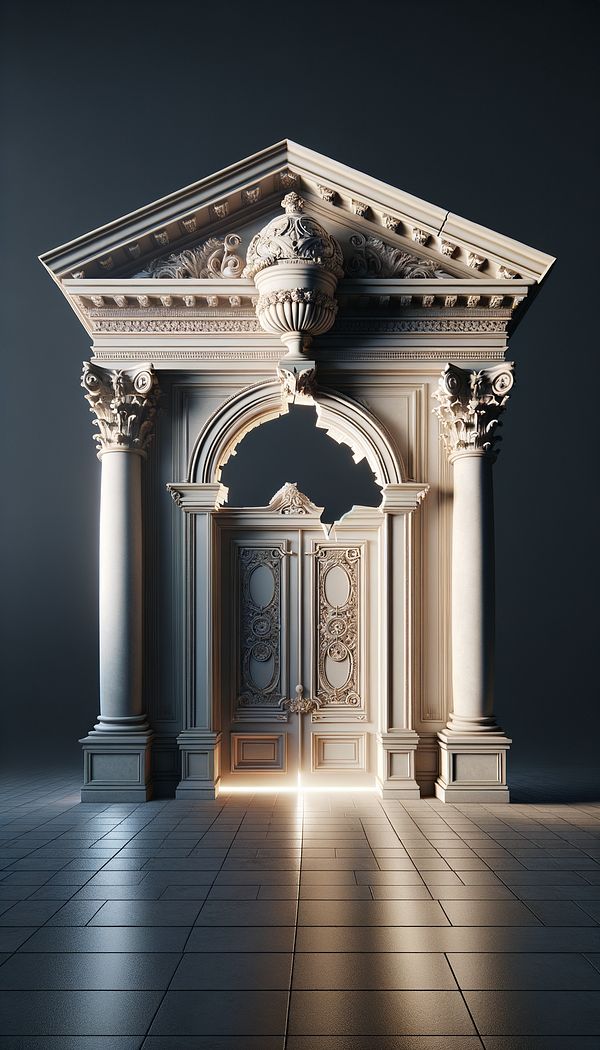What is a Broken Pediment?
A broken pediment is an architectural element that features a gap or break at its apex.
Description
A broken pediment is a decorative architectural element commonly found atop doorways, windows, and furniture, especially in classical and neoclassical designs. Characterized by its triangular shape, what sets a broken pediment apart from a traditional pediment is the gap or discontinuity at its apex. This stylistic feature adds a dramatic flair to the structure or piece it adorns, providing both visual interest and a sense of classical elegance.
Broken pediments often incorporate additional decorative elements within the break, such as finials, urns, or small sculptures, further enhancing their aesthetic appeal. In furniture design, a broken pediment might crown a bookcase or armoire, adding a touch of sophistication and historical depth. In architecture, it is most commonly associated with the Baroque and Rococo periods, where it was used to great effect in both religious and secular buildings to convey grandeur and opulence.
The use of a broken pediment can significantly impact the overall design of a space, bridging the gap between functionality and artistry. By integrating historical design elements in modern contexts, it allows for a unique blend of old and new, adding character and distinction to interiors and exteriors alike.
Usage
Broken pediments are seen in a variety of contexts within interior and architectural design. In architecture, they grace the facades of buildings, giving them a distinguished and elegant appearance. In interior design, broken pediments can be found adorning the tops of furniture pieces such as cabinets, bookcases, and grandfather clocks, adding a classical touch to the room's decor. They are particularly popular in design styles that favor ornate and elaborate detailing, such as traditional, Baroque, and Rococo-inspired interiors.
FAQs
-
How does a broken pediment differ from a traditional pediment?
A broken pediment is characterized by a gap or break at its apex, while a traditional pediment is a continuous triangular shape without interruptions.
-
Where are broken pediments commonly used?
Broken pediments are commonly used in architectural facades, as well as in interior design, particularly atop furniture pieces like cabinets, bookcases, and grandfather clocks.
-
Can broken pediments be incorporated in modern interior design?
Yes, broken pediments can be incorporated into modern interior design by adding a unique blend of historical elegance with contemporary styling, creating a distinctive and sophisticated look.
Practical Application
When incorporating a broken pediment into your design, consider the scale and proportion of the element in relation to the space or piece it is adorning. Balance the ornate detailing of the pediment with simpler surrounding elements to prevent overwhelming the design. Additionally, including a decorative element within the break of the pediment, such as a sculptural detail or an ornamental finial, can enhance its visual appeal and create a focal point.
-
Architectural Elements199 articles
-
Design Styles478 articles
-
Furniture Types599 articles
-
Decorative Objects240 articles
-
Historical Periods & Movements150 articles
-
BandingBanding refers to the decorative detail created by applying strips of material to the edges or borders of furniture, textiles, or architectural features.
-
Asian Zen StyleAsian Zen Style is a tranquil and minimalist interior design approach influenced by the simplicity and natural elements of Zen philosophy.
-
Claw & BallClaw & Ball is a decorative motif featuring a claw, paw, or talon grasping a ball, typically used in furniture legs.
-
Radiator CoverA radiator cover is a protective decorative casing placed around a radiator.
-
CarpetCarpet is a floor covering made from thick woven fabric.
